
Giovanni Greppi (Milan, September 19, 1884 - Milan, April 12, 1960) was an Italian architect best known for having designed some of the most famous military shrines in Italy. [1]

Giovanni Greppi (Milan, September 19, 1884 - Milan, April 12, 1960) was an Italian architect best known for having designed some of the most famous military shrines in Italy. [1]
Graduating from the Brera Academy in 1907, he took part in the competition for the facade of the Milan Central Station, finishing in second place. [2] He also won a scholarship that allowed him to travel and study abroad, and from 1908 to 1910 he attended the École des beaux-arts in Paris and also visited Istanbul. [1]
He also devoted himself to propaganda and advertising campaigns. During the First World War, for example, he produced a manifesto to support the raising of funds for the national loan. In 1924 he participated with numerous other artists in the famous catalog it:Veni vd vici for the entrepreneur it:Giuseppe Verzocchi.
Giovanni Greppi built a factory town on behalf of Dalmine between 1934-40 [3] and, together with Giovanni Muzio, the Palazzo della Cassa di Risparmio delle Provincie Lombarde in Milan: known as "Palazzo delle Colonne" due to the long portico on the facade, the building is considered by architectural historians as one of the most interesting bank buildings built in Milan between the wars. It is characterized by innovative engineering and technological solutions: its most notable element is five-floor underground vault. During the Second World War, it was considered the safest air-raid shelter in Milan: starting from June 1940, some of the most precious works of art from Milan’s museums were stored here. Greppi also designed the building of the Banca Popolare di Milano. [2]
He died in 1960 due to injuries from a road accident that had occurred in the spring of the previous year. He was buried in the cemetery of Craveggia. [1] On November 2, 2020 his name was entered in the Famedio of Milan. [4]

Greppi acquired international fame with his designs for military shrines: he had first approached the theme of honors for the war dead with the Military Memorial of Monte Grappa (1932-1935). [5] In addition, the commission for the construction of the Redipuglia War Memorial, chaired by General Cei, imposed Giovanni Greppi as architect and Giannino Castiglioni as sculptor, [5] [6] the two having a close-knit partnership since their time at the Academy. Under General Cei and together with Castiglioni, Greppi went on to design further memorials at Timau, Kobarid, Colle Isarco, Pian di Salesei, Passo Resia and San Candido. [2] [1]
In 1938 he also designed the military memorial of Bezzecca. Also in collaboration with Giannino Castiglioni he also built memorials abroad, in particular at Bligny in France, to honor the dead of the Garibaldi Legion on the Marne front. [2]
Greppi was also particularly active in the design of residential buildings; in particular, it is possible to point out:

The Cimitero Monumentale is one of the two largest cemeteries in Milan, Italy, the other one being the Cimitero Maggiore. It is noted for the abundance of artistic tombs and monuments.
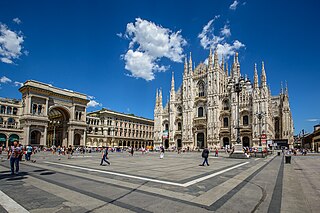
Piazza del Duomo is the main piazza of Milan, Italy. It is named after, and dominated by, Milan Cathedral. The piazza marks the center of the city, both in a geographic sense and because of its importance from an artistic, cultural, and social point of view. Rectangular in shape, with an overall area of 17,000 m2, the piazza includes some of the most important buildings of Milan, as well some of the most prestigious commercial activities, and it is by far the foremost tourist attraction of the city.

Achille Castiglioni was an Italian architect and designer of furniture, lighting, radiograms and other objects. As a professor of design, he advised his students "If you are not curious, forget it. If you are not interested in others, what they do and how they act, then being a designer is not the right job for you."

Gualtieri is a comune (municipality) in the province of Reggio Emilia, in the Italian region of Emilia-Romagna, located about 70 kilometres (43 mi) northwest of Bologna and about 25 kilometres (16 mi) north of Reggio Emilia on the right bank of the Po river. Historically, it suffered numerous floods, the last occurring in 1951. It is one of I Borghi più belli d'Italia.
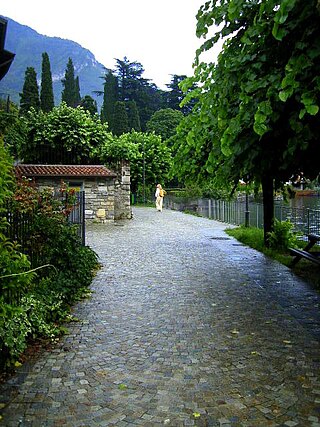
Lierna is a comune in the province of Lecco in Lombardy, in north-west Italy. It lies on the eastern shore of Lake Como, about 60 kilometres (37 mi) north of Milan and about 15 kilometres (9 mi) north-west of Lecco.

BBPR was an architectural partnership founded in Milan, Italy in 1932.

Giovanni Muzio was an Italian architect. Muzio was born and died in Milan. He was closely associated with the Novecento Italiano artists group.

Villas and palaces in Milan are used to indicate public and private buildings in Milan of particular artistic and architectural value. Milan has always been an important centre with regard to the construction of historical villas and palaces, ranging from the Romanesque to the neo-Gothic, from Baroque to Rococo.
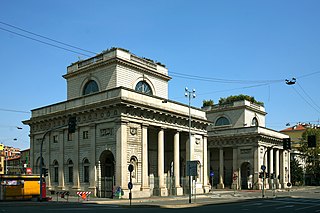
Porta Venezia is one of the historical gates of the city of Milan, Italy. In its present form, the gate dates back to the 19th century; nevertheless, its origins can be traced back to the medieval and even the Roman walls of the city.

Palazzo Castiglioni is an Art Nouveau palace of Milan, northern Italy. It was designed by Giuseppe Sommaruga in the Liberty style and built between 1901 and 1903. The rusticated blocks of the basement imitate a natural rocky shape, while the rest of the decorations are inspired by 18th century stuccos. The building is now used as the seat of the Unione Commercianti di Milano.

The Zone 1 of Milan, since 2016 officially Municipality 1 of Milan, is one of the 9 administrative divisions of Milan, Italy.
La Banda della Comasina is the name which the Italian media used to describe a criminal group active in the 1970s in robberies, kidnappings and weapons trafficking in the northern area of Milan: the Comasina. The area of action included the control of entire neighborhoods in Milan, with the presence of roadblocks controlled by the gang's members in which policemen were robbed and mocked.
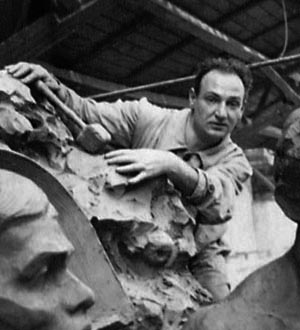
Giannino Castiglioni was an Italian sculptor and medallist. He worked mostly in monumental and funerary sculpture; his style was representational, and far from the modernist and avant-garde trends of the early twentieth century.

Luigi Caccia Dominioni was an Italian architect and furniture designer.

The Redipuglia War Memorial is a World War I memorial located on the Karst Plateau near the village of Fogliano Redipuglia, in the Friuli-Venezia Giulia region of northeastern Italy. It is the largest war memorial in Italy and one of the largest in the world, housing the remains of 100,187 Italian soldiers killed between 1915 and 1917 in the eleven battles fought on the Karst and Isonzo front.

The Italian Charnel House, Kobarid is an Italian military shrine in Kobarid, Slovenia. Sited on the battlefield of Caporetto, it houses the remains of 7,014 Italians who fell during the battles of the Isonzo.

The military memorial of Monte Grappa is the largest Italian military ossuary of the First World War. It is located on the summit of Monte Grappa between the provinces of Treviso and Vicenza, at 1,776 meters above sea level. Access to the memorial is via the Strada Cadorna, built by the army on the orders of General Luigi Cadorna to bring construction materials for the fortification on Monte Grappa in 1917.
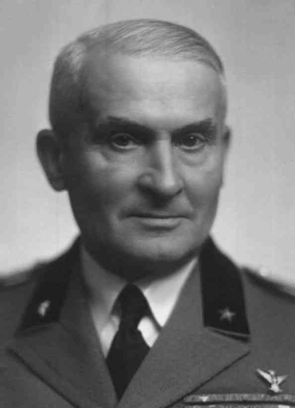
Ugo Cei was an Italian general and politician, who particularly distinguished himself during the First World War as brigade commander. In February 1935 he was appointed extraordinary Commissioner for honors for those who had died in war in Italy and abroad, and on March 25, 1939 he was made a Senator of the Kingdom. His decorations included the Knight Grand Cross and Officer of the Military Order of Savoy, three Medals of Military Valor and the War Cross of Military Valor.

Alessandro Mazzucotelli was an Italian craftsman, particularly known as a master ironworker and decorator. A specialist in wrought iron, Mazzucotelli linked his fame to the decorations of the works of the major exponents of Art Nouveau in Italy and abroad.